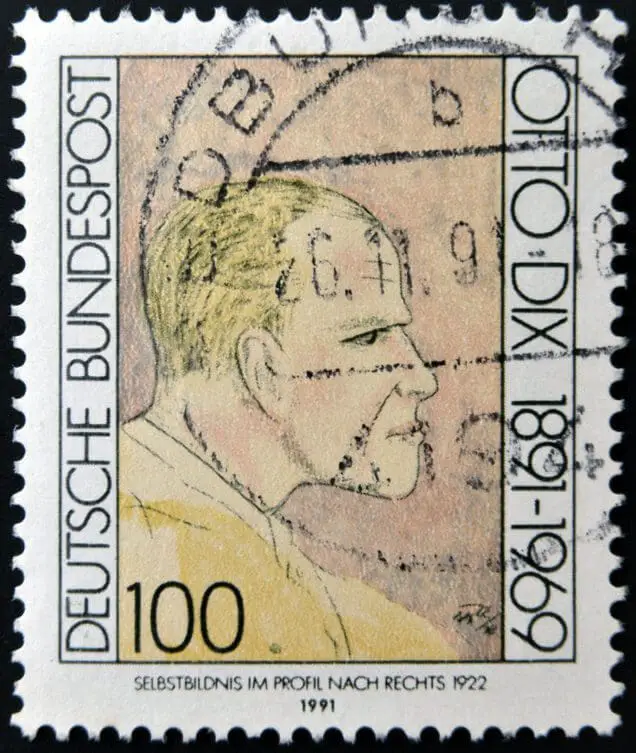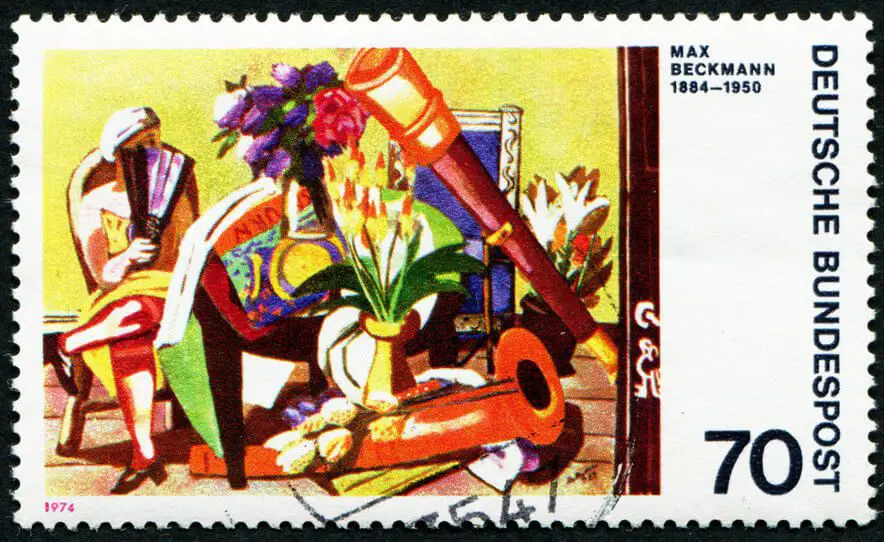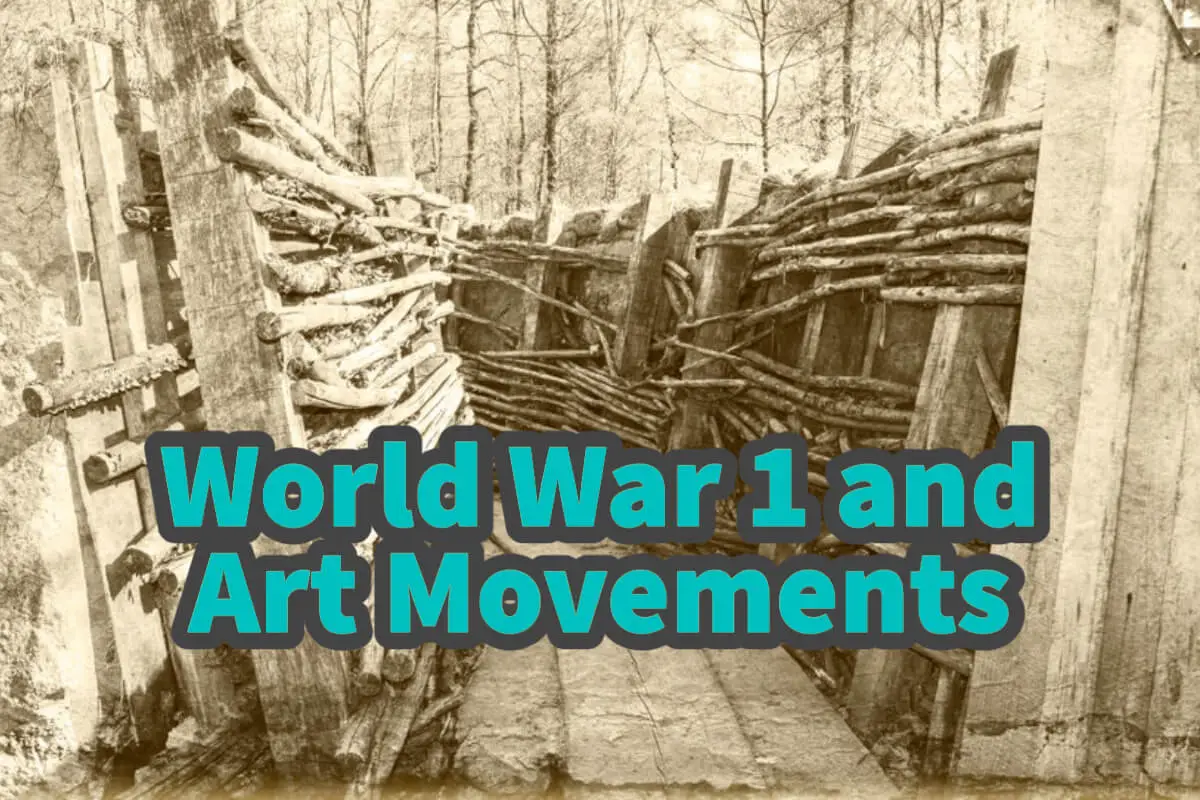History and art go hand-in-hand. Historical events affect the culture, politics, and arts of the day. World War 1 or the Great War of 1914- 1918, is such an example.
Many of the art movements after World War 1 came about as a direct protest about the devastation and loss of human life in the First World War. Many of these art movements also included cultural and political movements where like-minded artists band together to produce satirical and other art.
Table of Contents
New Art Movements and World War 1 1914 to 1918
World War 1 sent a shockwave through the world, especially in Europe, where the war was fought. Many called it the Great War and volunteered to sign up for the war as they believed in it. But, if they were lucky enough to return from the war, they forever changed many of these same men and women.
World War I was a fierce war, as all wars are. But in this war, also known as the Great War of 1914 to 1918, saw young men consistently cut to pieces by machine guns. The soldiers sat in disease-infested trenches where many died from starvation or disease.
There were 20 million deaths and 21 million people wounded during World War 1. Of these 20 million deaths, about 9.7 million were military personnel and just over 10 million civilians. Russia had the highest number of casualties even though it withdrew from the war earlier than others.
World War 1 or the Great War, was extraordinarily bloody and terrifying. Added to this was that many of the deaths were not due to the battle but to famine and disease.
It was a war that changed the world forever; there were so many first World War 1 that it changed how wars are fought.
Here are some of the firsts for that the First World War brought:
- First War was Fought on land, air, and sea.
- First air attacks on British Civilians.
- First widespread recognition of the shell shock or the psychological trauma suffered by the soldiers.
- First large-scale use of medical triage by the British forces. Triage is the system of which the medical personnel categorizes the treatment of the casualties.
- The first major use of poison gas.
- The first use of compulsory military service for British citizens
- First time tanks were used in combat
- First-time women served in the military. British women had a unit called W.A.A.C, or Women’s Army Auxiliary Corps.
- The first widespread use of both fixed and mounted mechanical flamethrowers in battles.
- First systematic use of camouflage units by the French Army.
One death of World War 1 was culture and arts, as the world once knew it. World War 1 tipped the arts and cultures of the world upside down, especially in Europe and the United States. It was a war to changed the world of art and art movements forever.
Many of these art movements directly protested the First World War. The art movements began to take on their own lives, being art movements and cultural and political movements.
World War 1 – Devastation of Expressionism Art
During World War 1, Expressionism was Europe’s most significant art movement, especially in Germany. When the war started, many Expressionists shared the enthusiasm of the war and joined up to fight.
The Expressionists felt World War 1 would wash away the old world order and create a better, less constrained society. They felt the war would bring a bright future to Europe. But as the realities of the war became apparent, these same Expressionism artists became disillusioned.
Before the First World War, Expressionism had two primary groups: Der Blaue Reiter (The Blue Rider) and Die Brucke (The Bridge). The Blue Rider was dissolved in 1913 as Vasily Kandinsky, a leading member of the Blue Rider Expressionism group, returned to Russia. The Brucke (The Bridge) also dissolved, but some members continued to paint with the same bold and emotionally charged Expressionism style.
Ernest Ludwig Kirchner, a former bridge group member, suffered a nervous breakdown due to his war experiences; other Expressionism artists such as George Grosz and Max Beckmann had some breakdowns. August Macke and Franz Marc were killed in battle.
In the art of Max Beckmann, who served as a medic during World War 1, you can see an apparent change in style between his pre-war and after-war paintings. Before the war, many of his paintings almost took on an Impressionist style; after the war, his paintings had firm contours and used many black colors.
Modernism (1860s to 1970s) and World War 1
Even though the Modernism Art Movement started in the mid to late 19th Century or before World War 1, modernist art was accelerated at a pace never before seen after the war.
The Tate Gallery defines the term Modernism as:
“Modernism refers to a global movement in society and culture that from the early decades of the twentieth century sought a new alignment with the experience and values of modern industrial life. Building on late nineteenth-century precedents, artists around the world used new imagery, materials and techniques to create artworks that they felt better reflected the realities and hopes of modern societies.”
Tate Galleries
From this definition, we learn that Modernism directly responded to society, culture, and what was happening at the time. If Modernism was in response to the Industrial Revolution, then one of the significant changes was how wars were fought and won, along with the weapons and warfare used in these wars.

Dada Art Movement and World War 1
Dada is an art movement that was formed during the First World War in Zurich, Switzerland. It was formed as a protest against the horrors and what was seen as the outright follies of war. The satirical and nonsensical nature of Dada art, poetry, and performances was at the heart of the Dada movement.
Dada artists felt that the war called into question every aspect of society. They were an anti-war movement that fought not on the streets in protests but with art. Hans Arp, a Dada artist, said:
Revolted by the butchery of the 1914 World War, we in Zurich devoted ourselves to the arts. While the guns rumbled in the distance, we sang, painted, made collages and wrote poems with all our might.
Tate Galleries
The Dada artist was anti-war and anti-bourgeois and politically aligned with the radical left. The Dada movement was more than just an artistic movement; it was also a political and social change movement.
New Objectivity Art Movement
Before World War 1 most of the art world was under the influence of Futurism and Expressionism. Both movements abandoned order and commitment to objectivity or traditional art. Expressionism was a dominant form of art in Germany and affected all German culture, including dance, theater, painting, architecture, poetry, and literature.
The New Objectivity Art Movement arose during the 1920s and was a reaction and challenge to Expressionism. It offered a return to unsentimental relatively and focused on the objective world.
New Objectivity is defined as:
“New Objectivity is the English translation of ‘Neue Sachlichkeit’, a German modern realist movement of the 1920s, described by one of its founders as ‘new realism bearing a socialist flavour’”
Tate Galleries
New Objectivity is associated with portraiture but usually had a kind of satirical manner to the paintings. Some well-known artists in the movement include Max Beckmann, Otto Dix, George Grosz, Alexander Kanoldt, Jeanne Mammen, and Georg Scholz.
Many of these artists knew through first-hand experience about the horrors of World War 1. Otto Dix served in the German army from 1915 to 1918. He was awarded the Iron Cross and the rank of “Feldwebel.” He was wounded in the neck.
Dix speaks of how he was profoundly affected by the sights of war; he said he had reoccurring nightmares of crawling from one destroyed house to another.
Many of these traumatic experiences are shown in his works of art. One of his more famous paintings is called The War (Der Krieg) or Dresden War Triptych. It is a large four-panel oil painting by Otto Dix. The painting is essentially an Anti War painting that shows the horrors of war, particularly the trench warfare of World War 1.
Today you can see Otto Dix’s work at the Otto Dix Haus Museum at Mohrenplatz 4, Gera, Germany. You can see over 400 pieces of his artwork at the museum.

Surrealism Movement
Surrealism was a cultural movement that developed in Europe after World War 1; the Dada art movement influenced the Surrealism movement. The word surrealist suggested beyond reality and was coined by the French Avant-garde poet Guillaume Apollinaire.
Like the Dada and New Objectivity movements, Surrealism influenced many aspects of the arts, including writings, poetry, and artwork. It was also a movement that had a manifesto (1924) that defined Surrealism as:
” …pure psychic automatism, by which one proposes to express, either verbally, in writing, or by any other manner, the real functioning of thought. Dictation of thought in the absence of all control exercised by reason, outside of all aesthetic and moral preoccupation.”
Tate Galleries
Many surrealist artists drew inspiration from mysticism, ancient cultures, and indigenous art as a way for them to imagine alternative realities. This is because the movement was about the liberation of the mind and artistic expression while also seeking political freedom.
Surrealism also has the element of surprise in the art. But many artists considered their work to be a philosophical movement first and foremost and the artwork secondary or as the outcome of the movement itself.
Like the Dada movement, many Surrealism artists also turned to political activism. Surrealism was not just about art but was also a cultural movement and a way of life.
Andre Breton is known as Surrealism’s founder and the Surrealist manifesto’s writer. Other prominent artistic figures included Jean Arp, Max Ernest, Andre Masson, Rene Magritte, Yves Tanguy, Salvador Dali, Pierre Roy, Paul Delvaux, and Joan Miro.
Frida Kahlo and Pablo Picasso are sometimes included in this group, but neither officially joined Surrealism. Frida Kahlo was adamant that she was not a Surrealism artist.
To learn more about Frida Kahlo, you can read Was the Mexican Artist Frida Kahlo (1907-1954) A Surrealism Artist? by clicking here.
Besides World War One, perhaps no other event affected art in Europe and mainly Germany than when Hilter came to power in the 1930s. Hiliter denounced the spate of modern artists as “degenerate.” This forced many of them into exile or to flee.
Artwork ceased and was destroyed. The Naxi campaign in condemning the artist helped shift the art world from Europe to New York City.
War, political campaigns, and culture affect art and artistic movements. World War 1 was so devasting that it affected the art and the artists of its day. The war also brought art movements that became a political and philosophical way of life.
Frequently Asked Questions
Why did new art movements emerge after World War 1?
The trauma and devastation of World War 1 led to a profound disillusionment with traditional values, prompting artists to seek new modes of expression and meaning in their work.
How did World War 1 impact the art world?
World War 1 shattered societal norms and traditional beliefs, encouraging artists to question established artistic styles and explore innovative forms of creative expression.
What were some prominent art movements that developed after World War 1?
Dadaism, Surrealism, Cubism, and Constructivism were some of the influential art movements that emerged, reflecting the shifting attitudes and perspectives of the post-war era.
How did Dadaism respond to the aftermath of World War 1?
Dadaism emerged as a protest against the senselessness of war and societal norms, embracing absurdity and chaos in its artworks to challenge conventional thinking.
What role did cultural and political movements play in these art movements?
Many artists found solace in collective movements that aligned with their social and political beliefs, using art as a means to critique authority and advocate for change.
How did Surrealism reflect the psychological impact of the war?
Surrealism delved into the subconscious mind, exploring dreams and irrational thoughts, often as a response to the psychological trauma experienced by individuals during the war.
Why did artists turn towards abstraction in the aftermath of World War 1?
Abstraction allowed artists to move away from representational art, offering a departure from reality and providing a way to process the chaos and instability of the post-war world.
Were there any positive outcomes from these art movements?
These art movements fostered a sense of artistic freedom and experimentation, leading to groundbreaking innovations that continue to influence contemporary art.
How did the concept of “anti-art” manifest in post-World War 1 movements?
The notion of “anti-art” was a rejection of traditional artistic norms and a challenge to established institutions, encouraging artists to redefine the boundaries of creative expression.
How did the development of new art movements contribute to societal change?
By challenging existing norms and fostering critical thinking, these art movements contributed to broader cultural and societal shifts, encouraging people to question authority and explore alternative perspectives.
Anita Louise Art is dedicated to art education, great artists, and inspiring others to find and create their art. We love art that uplifts and inspires. #ArtToMakeYouSmile! #ArtToMakeYouHappy!
If you want to see any of my art, you can find out more by clicking here. If you are interested in what inspires me and my paintings, you can discover more by clicking here.
We have a free newsletter and would love you to be part of our community; you can subscribe to the newsletter by clicking here. If you have any questions, I would be happy to talk to you anytime. You can reach me, Anita, by clicking here.
Subscribe to our Anita Louise Art YouTube Channel with great videos and information by clicking here.
Join us for our podcast “5 Minutes With Art.” Spend just 5 minutes a week with us to discover and learn about great art and artists. You can find out more about our podcast by clicking here.
Related Content
Abstract Painting Skills And An Artist’s Drawing Ability
When an artist is trained in drawing, composition, and color theory, their formal or informal training is reflected in their artwork. You can tell the artist’s skills by executing the painting using their drawing, composition, and color theory skills.
You can learn more by reading Abstract Painting Skills And An Artist’s Drawing Ability by clicking here.
What Is The Cultural Significance Of Abstract Expressionism Art?
The cultural significance of abstract expressionism art is it was a forerunner for the cultural changes that took place in the United States in the 1950s and 1960s. The Abstract Expressionism movement started after World War II in the 1940s and continued into the 1950s. The world saw great cultural shifts in the 1950s and the 1960s.
You can learn more by reading What Is The Cultural Significance Of Abstract Expressionism Art? by clicking here.

